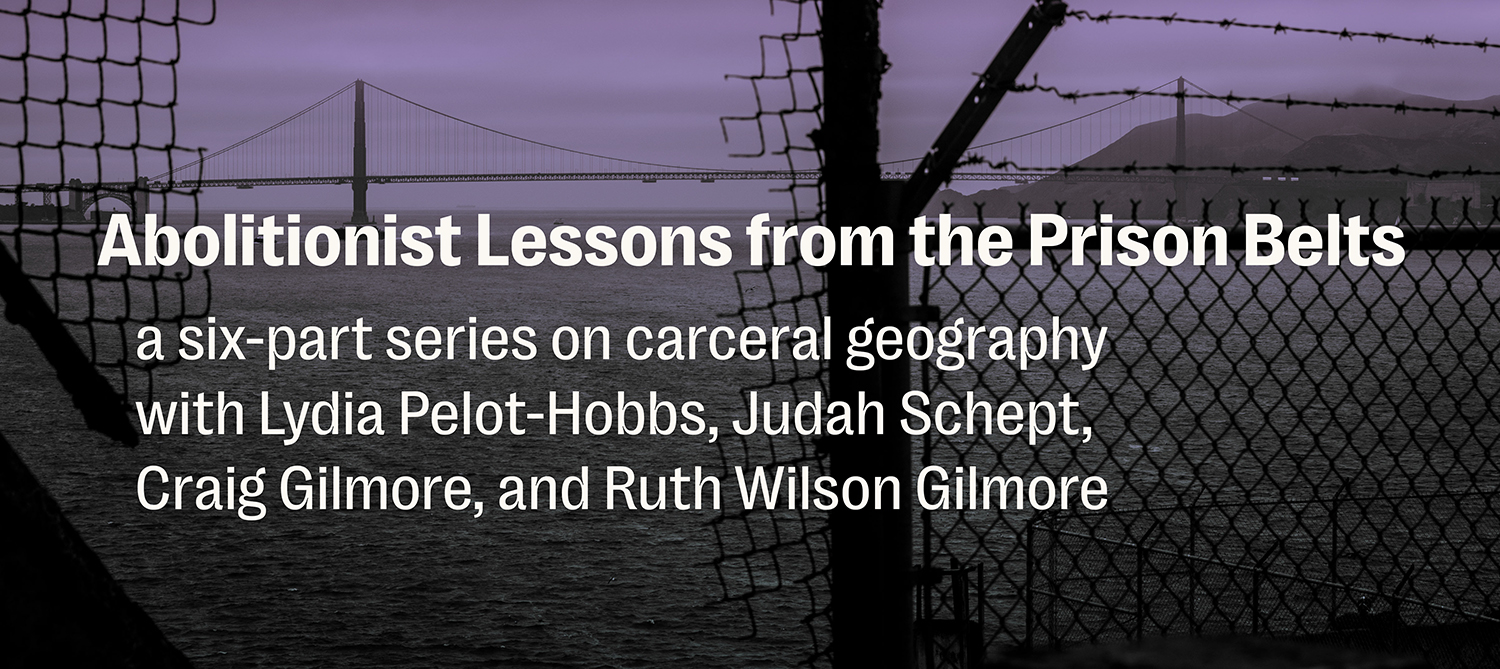
Joint action by abolitionists and environmental justice organizers didn’t come out of transactional coalition building, but from organizers’ work unearthing a shared set of movement interests: disposability, land use, organized abandonment, and consciousness. We discuss how organizations in both traditions have taken on each other’s struggles, forging common purpose among differently affected people facing both spectacular and everyday forms of harm in overlapping and discontinuous geographies. As these convergences form and share strategies across space, particularly since the foundational 2001 Joining Forces conference, they face opponents who likewise study and adapt, attempting to preempt levers campaigners had successfully pulled, which forces organizers to undertake careful work in consciousness and strategy to regroup for the next fight.
Ruth Wilson Gilmore: In the fight against building FCI Letcher in Kentucky, I was really moved by someone testifying against the prison at one of the public hearings, when he said, “Maybe we here in this community should be an environmental justice community.” He did not assume he could hail environmental justice to his own cause, perhaps because he’s white. Although of course he could and should. The commenter stretched our understanding of who might care about this, arguing that the prison fight should rightly be understood as a fight against environmental injustice.
Following the same lines in my written comments to the environmental impact report, I suggested that the Letcher community should join forces with whoever lives in the place where the toxic detritus of the construction—the equivalent of eight Empire State Buildings’ volume of mine spoil—would end up and, working as a geographically discontinuous environmental justice community, they could fight together.
These are possibilities for organizers to think about: how an understanding of a specific place-based vulnerability can be transformed into solidarity at regional and larger scales, with people that the local people don’t yet know.
So let’s discuss the themes of environmental justice as they relate to the struggle against the prison–industrial complex. The connections have been very clear to some of us for a long time, while for many others they remain surprising.
More from our decarceral brainstorm
Inquest, finalist for the 2025 National Magazine Award for General Excellence, brings you insights from the people working to create a world without mass incarceration.
Sign up for our newsletter to get the latest in your inbox every Saturday.
Newsletter
Lydia Pelot-Hobbs: Recently I gave a talk on climate disasters and mass criminalization and afterward someone came up to me and said, “Thank you for so clearly articulating why prisons are an environmental issue.” When she said that, what immediately came to mind for me was that while we take for granted that prisons are, of course, an environmental issue, this truth is still not realized by many people who are doing environmental studies or who identify as environmentalists.
For so many people, the relationship of prisons and the environment only come into view when we point to the most extreme examples of this relationship: “The prison will be built on a mountaintop removal site.” Or, “Jails in Southeast Louisiana are precarious due to increasing floods due to climate change.” Or, “In California incarcerated people are fighting wildfires.” For many people, unless it’s these extreme examples, it is still difficult to recognize the environmental facets of carceral geographies.
How can we get people to recognize these everyday relations—exacerbated in our current context by climate change but by no means new? When people incarcerated at Angola filed their lawsuit in the 1970s, a key complaint was that there was sewage being pumped right underneath their dorms and dining hall, making people ill. How can we bring to the forefront these environmental aspects not only when they are headline grabbing? How does our organizing make visible the everyday ways that environmental racism and environmental injustice are fundamental to the prison state in all of its forms?
Judah Schept: There’s an interesting parallel, Lydia, between the point you were just making and the ways we talk about police violence, or just the violence of the carceral state writ large. We can easily identify it when it is expressed in its most spectacular forms, like the police murders of George Floyd, or Breonna Taylor, or countless others. But we have a harder time identifying it as violence—and organizing around it as violence—when it’s a city council expanding a jail budget, or thousands of people subjected to daily arrests and short jail stints, or other seemingly mundane operations of the carceral state. There’s something that’s so visceral and egregious in a prison being built on a strip-mined mountaintop removal (MTR) site, where the environmental devastation has an almost cinematic quality. But we’re not necessarily able to organize around the more everyday expressions of the same social forces.
At the same time—maybe this is everywhere, but at least in particular in Appalachia—there are so many of those kinds of spectacular expressions that they can also feel somewhat mundane, because they just happen so often. There are prisons built on MTR sites, others built right next to coal slurry ponds, and still others, like a prison in Martin County, that had begun to sink into the abandoned mine shafts under them before construction had even been completed.
So, yes, there is something visceral and activating about those spectacular displays of carceral and environmental injustice or violence, which can bring people into struggle. We also cannot take that visceral reaction for granted, or assume its impact is identical for everyone and at all times. In other words, there is crucial work to be done around defining for the public the social and environmental meaning of a prison built on an MTR site. We still have to struggle in the arena of popular common sense to beat back the pacifying argument that the prison is the replacement of one kind of rural jobs industry for another and offer a narrative that names the layered extractive and carceral violence compounded by the prison project.
Going back to Ruthie’s original point, in the fight to stop FCI Letcher, the state chapter of the Sierra Club has actually become a central member of the coalition. As a state chapter, they have taken a position not only against FCI Letcher, but also against all prison and jail construction as an environmental issue. The chapter convinced the national Sierra Club to send out a text alert to every national member before the prison’s Final Environmental Impact Statement comment period was over to encourage their nationwide membership to write in. So there has already been a meaningful shift that has led to certain environmental groups not just joining a coalition because there’s some strategic point of overlap, but also to adopt an analysis of the prison–industrial complex as being a fundamental environmental justice issue.
Craig Gilmore: That makes me think of the people we knew who were involved with the Sierra Club in California, the Center for Biological Diversity, and the Environmental Law Alliance Worldwide conference that happens every year. There has been a group of people in the environmental movement—sometimes mainstream, sometimes on its more radical fringes—who’ve been talking about prisons for twenty years now. Planting those seeds along the way may or may not bear fruit in the current fight, but five or ten years from now, you’re shocked to find that an organization like the Sierra Club is on board. That’s the result of people in the movement educating themselves and doing that kind of internal organization and cross-organizational political education.
Judah Schept: That is such an important point. To build on that, Craig, in 2003 the Friends of the Kangaroo Rat were the named plaintiff in the lawsuit that successfully blocked the building of the Delano II prison project in California. Their role in that lawsuit very concretely informed the strategic choice of a local Kentucky plaintiff facing important environmental injuries from the project—an organization called Friends of the Lilley Cornett Woods and the North Fork River Watershed—for the amended lawsuit against USP Letcher in 2018–19, which proved to be decisive in stopping the prison the first time. Which is just to say we don’t know how the things that we’re doing right now may in fact inform very concrete ways that people are organizing, to say nothing of how people are thinking about their own struggles, ten, twenty, however many years later.
Lydia Pelot-Hobbs: This question of how consciousness gets built by movement activity—turning apparently boring questions of land-use procedure into skirmishes in fights for justice—is so important. What does it mean for people who’ve been abandoned structurally—who have had these spectacular forms of violence become everyday—to come to share an understanding of how we got here? People start saying, “Of course they want to put a prison here.” “Of course they don’t evacuate the jails.” There’s a shared consciousness, which people have developed through generations of struggle around these kinds of intrusions by extractive industries and against the withdrawal of life-sustaining supports. A sort of consciousness forms when people can politicize the accumulation of all of those little decisions that make us say “of course” to exceptional events in particular regions—everyday land-use decisions, everyday budget decisions, the mundane ways the devaluation of people’s lives in particular places gets put into practice. That consciousness could be defeatist, but organizational activity can help give shape in action to the interpretation we’re encouraging.
Ruth Wilson Gilmore: Land-use decisions frequently concentrate cumulative violence, whether it’s to humans, water, air, flora, or fauna such as kangaroo rats. It’s crucial to successful movement-building to be able to show to people whose organizations might join in solidarity with abolition movements, or become abolitionists themselves, that the accumulated harms of organized abandonment that they’re encountering are part of a continuum with the organized violence—including criminalization and incarceration—that got us all motivated in the first place. This consciousness-building is fundamental to all work that we do.
Lydia Pelot-Hobbs: Exactly. It’s good when people are moved by these egregious moments! It then becomes a question of how to extend their awareness to the violence that doesn’t take the most spectacular forms. How do we illuminate these dynamics and move people when it’s asking them to be involved in the least sexy moments? Like the land-use meetings, just over and over and over again.
Craig Gilmore: But we can’t simply wait for popular outrage at the next egregious moment. Law enforcement’s strategy is, “We can make the spectacular less spectacular by doing it more often and making it mundane, at least in terms of the news cycle.” Police killings haven’t gone down. Police killings have gone up in the United States, deaths in custody have gone up, but that’s harder and harder to organize around because it happens so fucking often. So I think it’s all the more essential that we figure out ways to successfully organize around the mundane. If some of the people who’ve been mobilized by the most spectacular and newsworthy events come along, that’s great.
Judah Schept: Returning to a point Craig made earlier, it’s important to think about how the state also studies wins and losses to inform their strategy for how they will expand tomorrow. In 2019 we thought that we had defeated USP Letcher, and the success owed a great deal to an environmental strategy. In 2022, devastating flooding happened across the region, which killed 45 people and destroyed something like 9,000 homes. Two months to the day after the floods, the Bureau of Prisons reproposed the prison for Letcher County. Even now, years later, people are still recovering, and the proposed cost of FCI Letcher exceeds the amount of money FEMA has devoted to the region. However, the BOP’s Environmental Impact Statement for the reproposed prison preemptively devoted some space to discussion of flooding, anticipating (although inadequately addressing) the kinds of opposition it would receive from us about the insanity of building a prison in a flood plain. It’s just an example of the BOP likely having studied our strategy from the first iteration of the fight and attempting to foreclose our ability to use the likelihood of flooding as grounds to block the project.
Ruth Wilson Gilmore: There’s a fantastic book from 1995, Repertoires and Cycles of Collective Action, edited by Marc Traugott. Some of the contributors (especially Charles Tilly) make exactly the point you describe: nothing that we’re fighting against has been completely uninformed by our prior fights. Repertoires emerge and become settled, and we can trace that by looking closely at eruptions of crisis.
For example, in the Kentucky context, I imagine the floods will continue to be a central part of any program or policy or concept, whether it’s from federal authorities, county administrators, or the state, not only because there was so much devastation from the floods, but also because political mobilization happened as a result of the floods. That compels us to ask how we can break cycles (that become opportunities for merely reformist reform) without being insensitive to the particular needs and motivations expressed by particular political mobilizations. How can organizers approach these moments so that we refresh people’s understanding of what is happening—for example, at the beginning of this conversation, I suggested fostering solidarity between a community from which minespoil is being removed and whatever community is slated to receive that toxic waste. Because the alternative is to yield to whoever (state, capital) attempts to domesticate movement energy: “Oh, we see the problem and we have a remedy that enhances already existing power differentials, including land-use decisions.” The process isn’t inevitable, but we need to think dynamically about the strategic common sense we’re building in order to prepare other people and ourselves for the next round of the fight.
Image: milky81 Kwon / Unsplash




